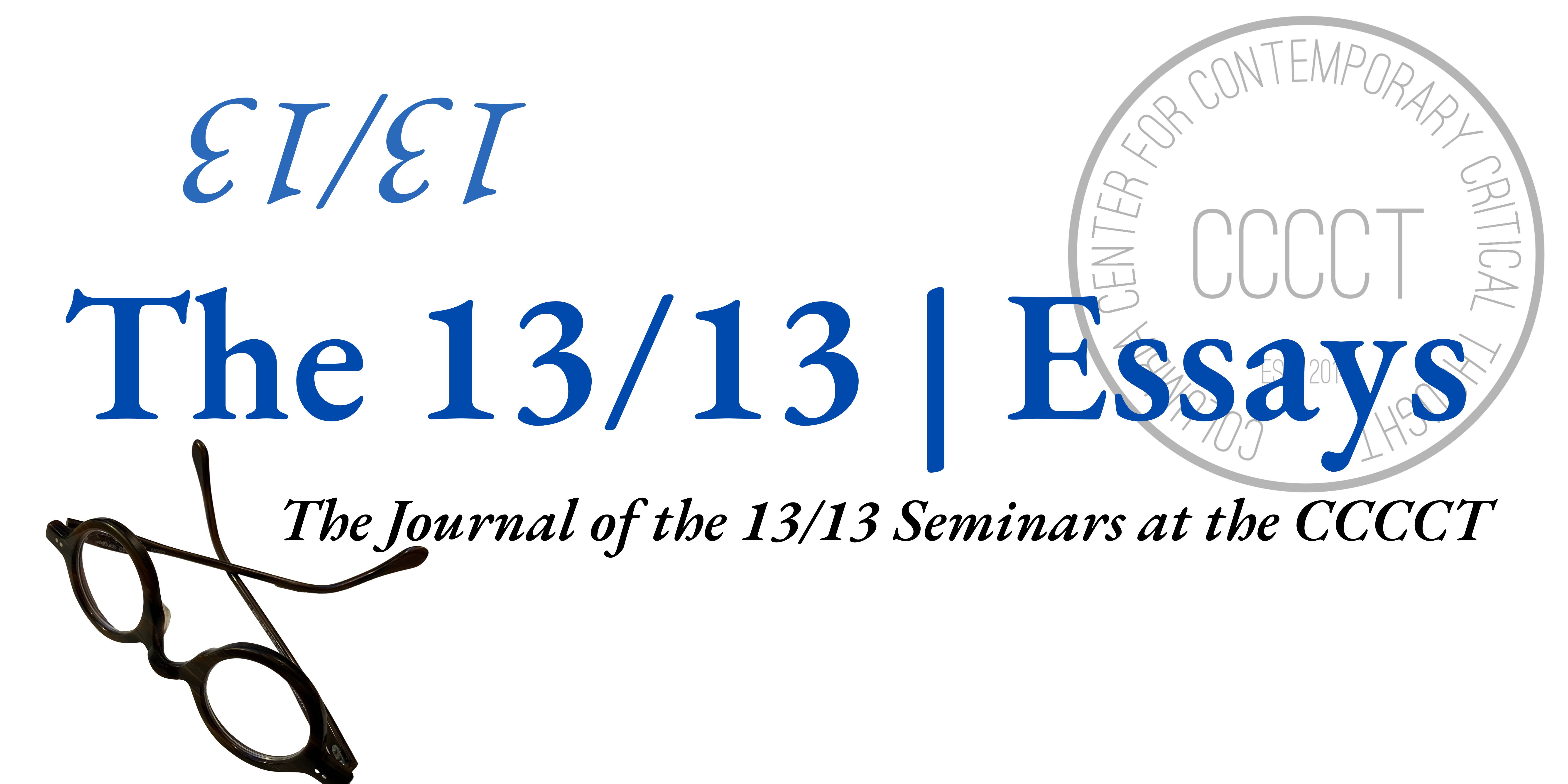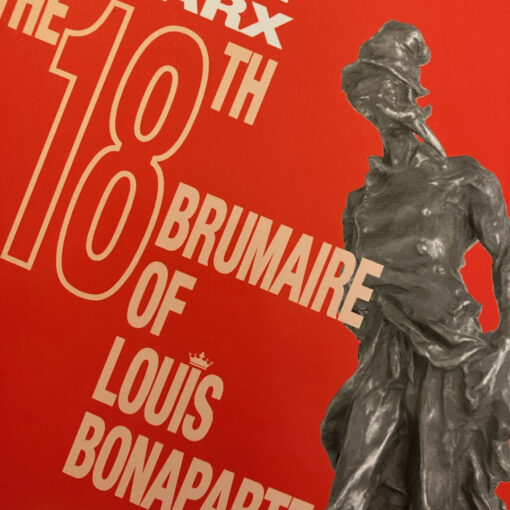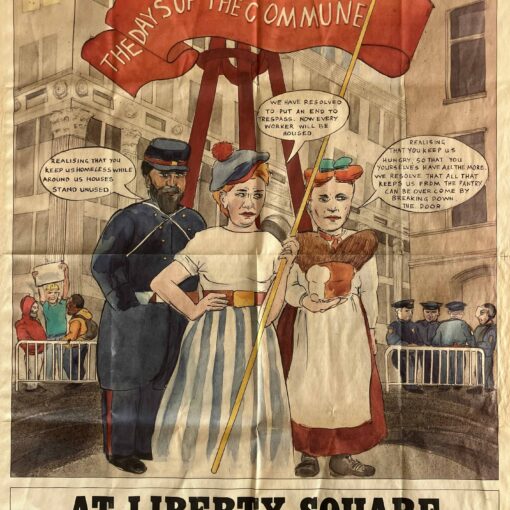By Bernard E. Harcourt
Eduardo Cadava and Sara Nadal-Melsió have created a masterpiece: an exquisite book that represents an experience in itself—an experience of reading, in collectivity, that opens us to a whole universe of solidarity, of critical thought, of praxis, of passion, of beauty. The book embodies a world of reading and writing, in three-dimensions, that gives life to a whole universe of practice: first, through a journey of reading the writings of Frederic Jameson, Walter Benjamin, Rosa Luxemburg, E.B. Du Bois, Cedric Robinson, and others, in conversation with the writings of Marx and Engels; second, though the creation of a community of critical thinkers and doers that we become part of as we enter this universe; and third, through an aesthetic experience that is perfectly curated with stunning reproductions of artwork, a spectacular book design, and a sensibility even to the touch, to the materials. In a new materialist way, this red book transforms the reader, the toucher, the thinker, the actor.
The book describes, but at the same time itself constitutes what Eduardo Cadava and Sara Nadal-Melsió call “a red common-wealth.” It elaborates, it instantiates, it breathes life into a common space that serves, in their words, to “counter the violence of global capitalism” and help guide us toward a possible future. Of this future, they write, “If its contours are traced in the skies and the stars, it is because we have yet to realize it on earth (nonetheless, its outline can be glimpsed in revolutionary moments, and especially in revolutionary texts).”[1] The texts the authors read and write become forms of resistance, forms of critique, that come to constitute what they call “a crack or fissure” that interrupts, destabilizes, and suspends the brutalities of our present world.[2]
The “red common-wealth,” then, is both a common wealth (a wealth held in common) and a commonwealth (like the frontispiece image of Marx and Engels’ doodles of the many little heads of people, resembling but transforming the famous Hobbes frontispiece of The Leviathan). The red common-wealth is a collective of texts, an archive, a collection, that, in reading and writing about, Eduardo Cadava and Sara Nadal-Melsió transform into a wellspring of practice. In the writings of Benjamin, Luxemburg, Du Bois, this red common-wealth turns into, in their words, “new coalitions among ever expanding acts of resistance.”[3]
Their book is about reading together as a form of resistance, of revolution, of political insurgency. It is about solidarity, about association, the term that Marx used to speak of collaborative, cooperative work. It is, again in their words, “a common-wealth of, in Marx’s phrase, ‘associated producers’”[4]—using the expression that Marx used to reference workers working together in forms of workshops and cooperatives to achieve a form of cooperation. The red common-wealth then, is a form of common, shared existence, and a horizon.
Eduardo Cadava and Sara Nadal-Melsió have a brilliant discussion of Marx’s Critique of the Gotha Program that reveals how much Marx’s attention to every word and expression was a form of political praxis. There is an important passage where they demonstrate the relation between critique, praxis, and writing—between Marx’s attention to the details of the language and expressions used in the Gotha platform, his critique that the expressions were too loose and imprecise, and his argument that the sloppiness opened the SAPD, Lasalle’s party, to criticism. Marx is particularly concerned by the use of words such as “equal right,” “fair distribution,” or “free state,” and argues that the text as written weakens the political movement, exposes it to criticism. Eduardo and Sara refer to Marx’s “critical reading protocols”: “The text is further evidence that critical reading protocols are a political practice; for Marx, the possibilities of communism cannot be imagined without committed, and even militant, readers and writers—with reading and writing not restricted to just linguistic practices, but expanded to include communist strategies for doing political work.”[5]
Of central importance to the book is the way in which the discussion of Marx, Benjamin, Luxemburg, and Jameson lead into an extended discussion of race and the legacy of slavery. The point of departure is a short passage from Jameson in which it is said that the reason socialism did not flourish in America is because of “race.” It is a passing reference, a short passage that only mentions race, but on its basis, Eduardo and Sara develop an extensive discussion of the history and theory of race conflict in the United States and an expansive reading of W.E.B. Du Bois, Cedric Robinson, American slavery, the murder of George Floyd, the summer 2020 protests, and the struggle for racial equality—all of which come to form the heart and the core of their readings and writings, of our red common-wealth.
It is especially interesting to read the last chapter of Politically Red in conversation with our most recent seminar, Marx 11/13 with Kohei Saito, on the Late Marx. Eduardo Cadava and Sara Nadal-Melsió highlight the ecological dimensions of Rosa Luxemburg’s work and her concern for the “devastating effects of industrial forestry and agriculture on the conditions of life.”[6] They elaborate the way in which Luxemburg was attentive to the squandering and exploitation of the earth, which of course ties directly to the late Marx. They discuss the work of Justus von Liebig, Agricultural Chemistry, and all the materials that we discussed with Kohei regarding the Late Marx, including Carl Fraas’s book on climate and the plant world, and Marx’s Ethnological Notebooks.[7]
Politically Red is a magnificent reading of Marx and his companions, Walter Benjamin, Rosa Luxemburg, W.E.B. Du Bois, Jameson, Cedric Robinson, and their interlocutors and readers. It is an archive embedded in a gallery of images, gorgeously reproduced, inspiring, mobilizing in their beauty, and evocative. Politically Red is a work of art, an ode to the red common-wealth.
It is an esthetic experience to handle the book. Every design dimension is thought through, the texture of the white indented cover, the way in which Andy Warhol’s silkscreen is superimposed on that cover page, and hangs like a painting, the red color of the edges of the book pages, the texture of the paper, the ink print, the reproductions of the images, the images themselves, stunning—everything about the book creates an experience for the reader. Every aspect of the physicality of the book enhances the experience of reading and writing, and offers an entry point into the red common-wealth. It is truly spectacular. You will notice even the binding. It is sewn. Not just glued. Notice the way the book opens, how the pages turn, how the seam bends. Some may think these are just details—but that would miss the whole experience that the reader enters into when they start reading this book. The fine texture of the cover, which is what the reader holds in their hand, gives life to the red common-wealth. The point is: this is a work of art and a treasure by means of which one enters, reading together, a space of practice, of hope, of imagination, for the future, for a “society of associated producers” and a “world of creative labor.”[8]
It is thrilling to welcome Eduardo Cadava back to the 13/13 series!
Like Marx, Luxembourg, Benjamin, Du Bois, and all the other writers who in turn evoked in each of their texts and under each of their names, this common-wealth belongs to the motility of an endless process without a subject that will not be silent in front of capitalist violence or shy away from its own violence, that is impossible to transform into dogma or to synthesize into a system, that will demand a reading that exceeds the text in order to make each text a site of encounters and possibility, that risks being political because it knows politics is the only means we have for not only encountering what is incalculable but also for maximizing it. It is a politics that can never have a determinate or fixed form and that, because of the danger of an almost inevitable complicity with what it believes goes in the direction of the worst, must remain in movement. The task is how to set the masses in motion, and, as we have seen, this task is folded into an activity of reading and writing that, accumulating its force through the common-wealth it mobilizes, reminds us that whenever we think and struggle for change, we are never alone.[9]
— Eduardo Cadava and Sara Nadal-Melsió, Politically Red
Watch the keynote seminar with Eduardo Cadava here!
Notes
[1] Eduardo Cadava and Sara Nadal-Melsió, Politically Red (Cambridge: MIT Press, 2023), at p. 285.
[2] Cadava and Nadal-Melsió, Politically Red, at p. 285-286.
[3] Cadava and Sara Nadal-Melsió, Politically Red, at p. 286.
[4] Cadava and Sara Nadal-Melsió, Politically Red, at p. 287.
[5] Cadava and Sara Nadal-Melsió, Politically Red, at p. 307.
[6] Cadava and Sara Nadal-Melsió, Politically Red, at p. 309.
[7] Cadava and Sara Nadal-Melsió, Politically Red, at p. 310-317.
[8] Cadava and Sara Nadal-Melsió, Politically Red, at p. 314.
[9] Cadava and Sara Nadal-Melsió, Politically Red, at p. 330.





